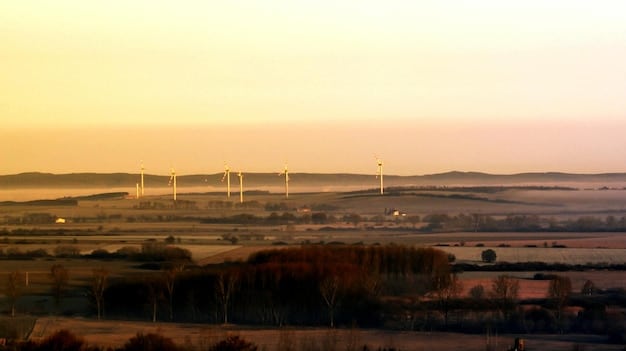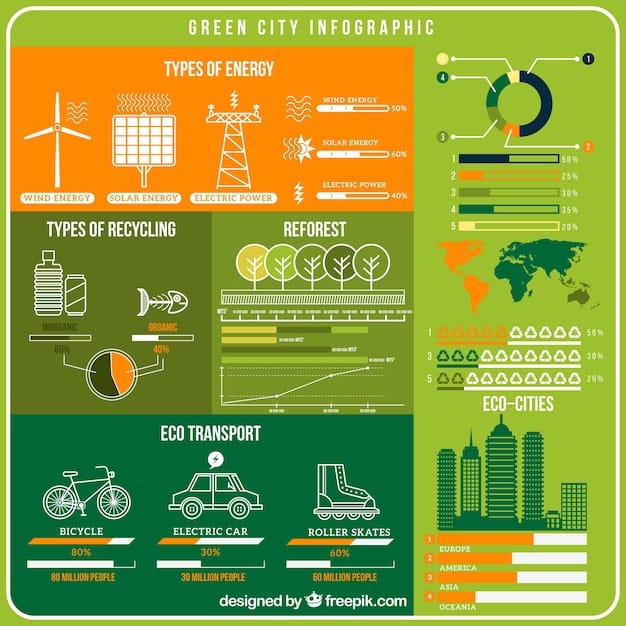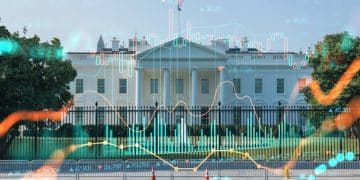US Energy Policy: Navigating the Transition to Renewable Energy Sources

The United States energy policy is at a critical juncture, balancing the traditional reliance on fossil fuels with a pressing need to transition towards renewable energy sources to meet environmental goals and ensure future energy security within a global context.
The complexities surrounding US Energy Policy: Navigating the Transition to Renewable Energy Sources present a multifaceted challenge, demanding a delicate balance between economic stability, energy security, and environmental stewardship. This transition is not merely a technical overhaul but a profound societal shift, impacting industries, communities, and every aspect of daily life across the nation. Understanding the intricate dynamics at play is crucial for grasping the trajectory of America’s energy future.
The Evolving Landscape of US Energy Policy
US energy policy is in a constant state of evolution, shaped by technological advancements, geopolitical realities, and growing environmental concerns. Historically, the nation’s energy strategy heavily favored fossil fuels, given their abundance and established infrastructure. However, the paradigm is shifting, driven by a global consensus on climate change and the increasing viability of renewable alternatives.
The journey from a fossil-fuel-dominated system to one powered by sustainable sources is complex and fraught with both opportunities and obstacles. This involves not only significant investment in new technologies but also the challenging process of decommissioning old infrastructure and re-skilling the workforce. The political will to enact transformative change is often tested by short-term economic considerations and regional interests.
Historical Context and Drivers of Change
For decades, US energy policy prioritized energy independence and economic growth, largely achieved through domestic oil, natural gas, and coal production. This approach provided a stable energy supply but came at an environmental cost. The late 20th and early 21st centuries saw a growing awareness of climate change, pollution, and resource depletion, prompting a reevaluation.
- Environmental Imperatives: Concerns over greenhouse gas emissions and their impact on global warming have become a primary driver for renewable energy adoption.
- Technological Advancements: Breakthroughs in solar, wind, and battery storage technologies have made renewables increasingly cost-competitive.
- Energy Security: Diversifying the energy mix reduces reliance on volatile global fossil fuel markets, enhancing national security.
Key Policy Instruments and Their Impact
The federal government employs various policy instruments to steer the energy transition. These include tax incentives, grants, research and development funding, and regulatory frameworks. State-level policies, such as Renewable Portfolio Standards (RPS), also play a significant role in driving local renewable energy deployment.
The interplay between federal and state policies can create a patchwork of regulations, sometimes leading to inefficiencies or disparate rates of adoption across the country. Understanding these nuances is critical for assessing the overall progress of the transition. Furthermore, international agreements and global energy trends also influence domestic policy decisions, highlighting the interconnectedness of energy systems worldwide.
The transition is not without resistance. Entrenched interests in the fossil fuel industry often lobby against policies favoring renewables, citing potential job losses and economic disruption. Balancing these concerns with the broader environmental and long-term economic benefits of a green energy future is a constant challenge for policymakers.

Moreover, the integration of new energy sources into an aging grid infrastructure presents substantial technical hurdles. Modernizing the grid to handle intermittent renewable energy sources, such as wind and solar, requires massive investment and innovative engineering solutions. Grid resilience, cybersecurity, and efficiency are all paramount considerations in this evolving energy landscape.
Public perception and acceptance also significantly shape energy policy. Educating the public about the benefits of renewable energy, addressing concerns about cost and reliability, and ensuring equitable distribution of benefits are vital for securing broad support for the transition. This entails transparent communication and community engagement.
In conclusion, the evolving landscape of US energy policy is a dynamic arena, marked by a critical shift towards sustainability. It is a complex interplay of historical legacies, technological progress, environmental imperatives, and diverse socio-economic interests. Navigating this transition effectively requires astute policymaking, continuous innovation, and strong societal buy-in, ensuring a robust and sustainable energy future for the nation.
Challenges and Opportunities in Renewable Energy Integration
Integrating renewable energy sources into the existing grid infrastructure is a complex undertaking, presenting a unique set of challenges and opportunities. While the potential benefits of a clean energy future are immense, the practicalities of transitioning from a centralized, fossil-fuel-based system to a decentralized, renewable-heavy one require careful planning and significant investment. This section delves into the technical, economic, and procedural hurdles, alongside the burgeoning prospects.
The intermittent nature of sources like solar and wind power, for instance, demands sophisticated grid management solutions and significant storage capabilities to ensure reliability. Furthermore, the geographical distribution of renewable resources often necessitates new transmission lines, which can be costly and face local opposition. Overcoming these integration challenges is paramount for accelerating the transition.
Technical and Grid Modernization Hurdles
The current US electrical grid was not designed to accommodate the variable nature of renewable energy. Traditional power plants provide a constant, dispatchable power supply, whereas solar and wind output fluctuates with weather conditions. This variability poses challenges for grid stability and reliability.
- Intermittency: Solar power is only available when the sun shines, and wind power depends on wind speeds, leading to periods of oversupply or undersupply.
- Storage Solutions: The need for scalable and cost-effective energy storage, such as utility-scale batteries, is critical to store excess energy and release it during peak demand or low renewable generation periods.
- Transmission Infrastructure: Many prime renewable energy sites are located far from major demand centers, requiring new, high-capacity transmission lines, which often encounter permitting and right-of-way challenges.
Economic and Market Dynamics
While the cost of renewable technologies has decreased dramatically, upfront capital investment for large-scale projects can still be substantial. Market mechanisms need to be adjusted to properly value the environmental benefits and grid services provided by renewables. The retirement of fossil fuel assets also impacts local economies and complicates the financial landscape.
The wholesale electricity markets, historically designed for thermal generation, are adapting to the influx of variable renewables through new market designs and pricing mechanisms. Ensuring fair competition and appropriate compensation for all energy sources is vital for attracting necessary investments. Moreover, the economic transition must consider the impact on communities reliant on fossil fuel industries.
The creation of new job opportunities in the renewable energy sector is a significant economic opportunity. These jobs span manufacturing, installation, operation, and maintenance, offering new pathways for economic growth. Furthermore, reduced reliance on imported fuels can improve the nation’s trade balance and enhance energy independence, providing long-term economic stability.
However, the economic benefits are not uniformly distributed, and ensuring an equitable transition is crucial. Policies addressing workforce retraining and economic diversification in regions historically dependent on fossil fuels are essential to mitigate adverse impacts. This holistic approach ensures that the shift benefits society as a whole while minimizing disruption.
In summary, integrating renewable energy into the US energy fabric is a formidable yet solvable challenge. It demands innovative technical solutions for grid modernization, adaptive economic frameworks to incentivize investment, and careful consideration of social equity. Addressing these issues proactively unlocks the vast opportunities presented by a clean energy future, fostering a more resilient and sustainable energy system for generations to come.
Policy Levers and Legislative Frameworks
The transition to renewable energy sources is heavily dependent on robust policy levers and supportive legislative frameworks. These mechanisms provide the necessary incentives, regulations, and funding to drive investment, foster innovation, and overcome market barriers. Understanding the array of policy tools at the disposal of federal and state governments is crucial for appreciating the pace and direction of the US energy transition.
From tax credits to direct investments in research and development, these policies aim to level the playing field for emerging clean technologies against established fossil fuel industries. They also address market failures, such as the negative externalities of pollution, by promoting cleaner alternatives. Effective policy design is responsive to evolving technological and economic realities, ensuring continued momentum towards sustainable energy goals.
Federal Initiatives and the Role of Congress
Federal legislation plays a pivotal role in shaping the national energy landscape. Congress has enacted significant laws, such as the Inflation Reduction Act (IRA), which provides substantial tax credits and incentives for renewable energy deployment, energy efficiency, and electric vehicle adoption. These acts represent considerable long-term commitments to decarbonization.
- Tax Incentives: Investment Tax Credits (ITC) and Production Tax Credits (PTC) significantly reduce the upfront costs and operating expenses of renewable energy projects.
- Research & Development Funding: Agencies like the Department of Energy (DOE) fund advancements in areas such as advanced battery storage, grid modernization, and next-generation renewable technologies.
- Regulatory Standards: Federal agencies establish emissions standards for power plants and vehicles, indirectly encouraging cleaner energy adoption.
State-Level Policies and Their Diversity
States often lead the way in renewable energy adoption through their own policy frameworks. Renewable Portfolio Standards (RPS) mandate that a certain percentage of electricity come from renewable sources, providing a stable demand signal for developers. Net metering policies and local permitting processes also significantly influence project viability.
The diversity of state policies reflects varying local resource availability, economic priorities, and political landscapes. While this can lead to fragmented markets, it also allows for policy experimentation and the identification of best practices. Collaboration between federal and state governments is essential to create a cohesive national strategy for renewable energy deployment.
However, policy implementation can face hurdles, including budget constraints, political shifts, and legal challenges. Sustained political will and bipartisan support are often necessary to ensure the longevity and effectiveness of these legislative frameworks. The impact of policy on job creation and economic growth is closely monitored, with an emphasis on ensuring these benefits are widely distributed.
Furthermore, international policy agreements and global climate goals exert an influence on domestic legislative priorities. The US commitment to global decarbonization efforts reinforces the need for robust internal policies. This external pressure can act as a catalyst for more ambitious domestic targets and accelerated implementation.
In essence, policy levers and legislative frameworks are the engines driving the US energy transition. Through strategic incentives, regulatory clarity, and sustained investment in innovation, these policies aim to overcome barriers and accelerate the shift towards a sustainable, resilient, and economically vibrant energy future. Continuous evaluation and adaptation of these frameworks are critical to meet evolving challenges and opportunities.
The Role of Technological Innovation and Research
Technological innovation and continuous research are indispensable for accelerating the US transition to renewable energy sources. While current technologies have made significant strides, further breakthroughs are needed to enhance efficiency, reduce costs, improve storage capabilities, and address grid integration complexities. Investment in R&D acts as a catalyst, pushing the boundaries of what is possible in the energy sector.
From advanced materials for solar cells to novel battery chemistries and smart grid technologies, innovation underpins every aspect of a clean energy future. These advancements not only make renewable energy more competitive but also open up new avenues for energy generation and consumption. A robust R&D ecosystem supports rapid prototyping, testing, and deployment, ensuring the US remains at the forefront of energy technology.
Breakthroughs in Renewable Energy Generation
Significant progress has been made in improving the efficiency and reducing the cost of solar photovoltaic (PV) panels and wind turbines. Research is ongoing in areas such as perovskite solar cells, which promise higher efficiency and lower manufacturing costs, and offshore wind technologies that can harness stronger, more consistent winds.
- Solar PV: Innovations are focusing on bifacial modules, thinner films, and increased energy conversion efficiencies under various light conditions.
- Wind Power: Development includes larger turbine blades, floating offshore platforms, and advanced control systems to optimize energy capture.
- Geothermal and Hydropower: Improvements in enhanced geothermal systems and advanced hydropower designs are exploring new ways to harness these consistent renewable resources more efficiently.
Energy Storage and Grid Modernization
The development of advanced energy storage solutions is critical to address the intermittency of solar and wind power. Research spans various battery chemistries, including solid-state and flow batteries, as well as alternative storage methods like pumped hydro and compressed air. Concurrently, innovation in grid technologies is essential for managing a decentralized energy system.
Smart grid technologies, powered by advanced sensors, communication networks, and artificial intelligence, enable real-time monitoring and control of energy flows. This optimizes renewable integration, improves grid resilience, and facilitates demand response programs. Cybersecurity measures are also paramount to protect this increasingly digital infrastructure from threats.
The synergy between technological innovation and public policy is crucial. Government funding for basic and applied research, coupled with incentives for commercialization, helps de-risk new technologies and accelerates their market adoption. Partnerships between academia, industry, and government agencies foster a collaborative environment conducive to rapid advancement.
However, the path from laboratory to large-scale deployment is often long and expensive. Bridging this “valley of death” requires sustained investment and supportive regulatory frameworks. Moreover, ensuring equitable access to these new technologies and preventing digital divides is an important consideration in policy design.
In summary, technological innovation and dedicated research form the backbone of the US energy transition. By continually pushing the boundaries of what is feasible in renewable energy generation, storage, and grid management, the nation can build a more efficient, reliable, and sustainable energy infrastructure. This commitment to R&D not only addresses current challenges but also lays the groundwork for future energy solutions.
Economic Implications and Job Creation
The transition to renewable energy sources carries significant economic implications for the United States, extending from job creation and investment patterns to energy costs and global competitiveness. While the shift may present challenges for traditional fossil fuel industries, it also unlocks immense opportunities for economic growth, innovation, and the creation of a new, resilient energy economy. Understanding these dynamics is crucial for formulating effective transition strategies.
The green energy sector is emerging as a major job creator, offering diverse employment opportunities across various skill levels. Investment in renewable energy infrastructure stimulates economic activity, attracting both domestic and international capital. This transformation is not merely an environmental imperative but a powerful engine for building a more sustainable and prosperous economic future.
Job Market Shifts and Workforce Development
The renewable energy sector is experiencing rapid job growth, with positions spanning manufacturing, installation, operations, and maintenance. While some fossil fuel jobs may decline, the net effect on employment is generally positive, assuming adequate workforce retraining and development programs are in place to facilitate transitions.
- Growth Areas: Solar panel installers, wind turbine technicians, battery manufacturing, and smart grid engineers are experiencing high demand.
- Retraining Initiatives: Programs aimed at reskilling workers from traditional energy sectors for new roles in the clean energy economy are vital for an equitable transition.
- Local Economic Impact: Renewable energy projects can bring economic benefits to rural communities through new tax revenues and local employment.
Investment and Economic Growth
The increasing attractiveness of renewable energy as an investment class is drawing significant private capital. Government incentives, coupled with falling technology costs, make clean energy projects increasingly competitive. This influx of investment stimulates economic growth by creating new businesses, fostering innovation, and boosting manufacturing capabilities.
The transition also offers long-term economic stability by reducing exposure to volatile global fossil fuel markets. Domestic renewable energy production enhances energy independence, buffering the economy from geopolitical disruptions and price swings. Furthermore, the development of a strong domestic supply chain for renewable energy components can create further economic resilience and export opportunities.
However, the economic transition must be managed carefully to mitigate potential negative impacts on communities heavily reliant on fossil fuel industries. Strategies for economic diversification in these regions, including investments in new industries and community development, are crucial to ensure a just transition for all. This proactive approach minimizes social disruption while maximizing economic benefits.
Moreover, the potential for lower long-term energy costs, as renewable sources often have minimal ongoing fuel costs after initial investment, can benefit consumers and businesses alike. This contributes to increased competitiveness for industries and improves the disposable income of households. The long-term economic dividends of a robust renewable energy sector are substantial, extending beyond mere energy production.
In summary, the economic implications of the US energy transition are profound and largely positive, particularly in terms of job creation and investment. By strategically managing the shift, particularly through workforce development and community support, the nation can harness these economic opportunities to build a more resilient, innovative, and prosperous clean energy economy for the future.
International Context and Global Energy Transition
The US energy policy, particularly its transition to renewable energy, does not operate in isolation but is deeply intertwined with the international context and global energy transition efforts. The world is collectively grappling with climate change, energy security, and sustainable development, making international cooperation and leadership crucial. How the US navigates its energy transition influences global efforts and vice versa.
The scale of the climate challenge necessitates a coordinated global response, where major economies like the US play a leading role in decarbonization. International technology transfer, shared best practices, and collaborative R&D are essential for accelerating the global shift away from fossil fuels. Understanding these global dynamics provides a broader perspective on domestic policy choices and their ramifications.
Global Climate Commitments and US Leadership
The United States’ commitment to international climate agreements, such as the Paris Agreement, sets a framework for its domestic energy policies. Re-engaging with global climate efforts signals a renewed dedication to reducing emissions and fostering international collaboration on clean energy technologies. US leadership in this domain can inspire and facilitate similar transitions in other countries.
- Paris Agreement: The US re-entry and updated Nationally Determined Contribution (NDC) reinforce its commitment to ambitious emission reduction targets.
- International Forums: Participation in G7, G20, and UN climate summits allows for coordination on climate finance, technology sharing, and capacity building.
- Bilateral Partnerships: Collaborations with key countries on renewable energy projects and research accelerate global innovation and deployment.
Geopolitical Implications of Energy Transition
The global shift to renewable energy has significant geopolitical implications. It can alter power dynamics by reducing the strategic importance of fossil fuel-rich nations and enhancing energy independence for many countries. This transition can foster new alliances based on shared clean energy goals and technological cooperation.
Conversely, it also presents challenges, such as ensuring critical mineral supply chains for renewable technologies and managing the economic shifts in fossil fuel-dependent economies. The US strategy must consider these geopolitical shifts to maintain its influence and secure its strategic interests in a decarbonizing world.
The global energy transition also creates new markets for clean energy technologies and services, providing economic opportunities for countries that lead in innovation and manufacturing. The US has the potential to be a major exporter of renewable energy technologies, contributing to its economic growth and strengthening its diplomatic ties.
However, competition in the green technology sector is intense, particularly from nations that have heavily invested in their renewable energy industries. Maintaining a competitive edge requires sustained domestic investment in R&D, robust manufacturing capabilities, and supportive trade policies. This global race to green technologies shapes future economic and political landscapes.
In conclusion, the US energy transition is not an isolated endeavor but an integral part of a larger global movement towards sustainable energy. By actively participating in international climate efforts, fostering technological collaboration, and adapting to new geopolitical realities, the US can play a pivotal role in accelerating the global energy transition. This interconnected approach is essential for addressing shared environmental challenges and fostering a more stable and sustainable world.
Future Outlook and Policy Imperatives
The future outlook for US energy policy, particularly concerning the transition to renewable sources, is characterized by both immense potential and persistent challenges. While significant progress has been made, the pace and scale of decarbonization required to meet climate goals demand continuous effort, adaptive policymaking, and sustained innovation. This section explores the trajectory of this transition and identifies key policy imperatives for a secure and sustainable energy future.
Achieving a significant shift away from fossil fuels requires not only technological readiness but also a robust regulatory environment, strategic investments, and strong public support. The path forward involves navigating complex trade-offs, addressing infrastructure needs, and ensuring social equity in the distribution of transition benefits. The coming decades will define the success of this monumental undertaking.
Accelerating Deployment and Decarbonization Pathways
Achieving the ambitious climate targets will require an accelerated deployment of renewable energy technologies across all sectors—electricity, transportation, industrial, and residential. This involves not just building more wind and solar farms but also electrifying transportation, optimizing industrial processes, and improving building efficiency. Diverse pathways to decarbonization are being explored and implemented.
- Grid Modernization: Continued investment in smart grids, energy storage, and long-distance transmission is essential for handling large-scale renewable integration.
- Carbon Capture and Storage: While controversial for some, CCS technology for hard-to-abate industrial emissions could play a role in certain sectors.
- Nuclear Energy: Advanced nuclear technologies are being re-evaluated for their potential as a reliable, carbon-free baseload power source.
The imperative of a Just Transition
Ensuring that the benefits of the energy transition are broadly shared, and that communities currently reliant on fossil fuel industries are not left behind, is a critical policy imperative. A “just transition” involves retraining programs, economic diversification initiatives, and community investments to support workers and regions impacted by the shift away from fossil fuels.
This commitment to equity strengthens public support for the transition and prevents social and economic disruption. Policy must address disparities in access to clean energy technologies and ensure that vulnerable populations benefit from energy efficiency upgrades and lower energy costs. Prioritizing equity is not just a moral imperative but also a practical necessity for a successful transition.
Moreover, the role of international collaboration cannot be overstated. Sharing technological advancements, policy best practices, and financial resources on a global scale can accelerate the transition for all nations. US leadership in this arena, both through diplomatic channels and direct partnerships, helps foster a collective effort towards a sustainable future.
The long-term vision encompasses not just climate mitigation but also enhanced energy security, improved public health, and increased economic competitiveness. Realizing this vision demands sustained political will, continuous innovation, and a flexible, adaptive policy framework that can respond to emerging challenges and opportunities. The future of US energy policy is a testament to the nation’s capacity for innovation and resilience.
In essence, the future outlook for US energy policy is one of continuous evolution and strategic adaptation. The policy imperatives are clear: accelerate renewable energy deployment, modernize the grid, invest in advanced technologies, ensure a just transition for all communities, and maintain strong international leadership. By embracing these challenges and opportunities, the US can successfully navigate the transition to renewable energy sources, securing a more sustainable and prosperous future.
| Key Point | Brief Description |
|---|---|
| 🌍 Policy Evolution | US energy policy is shifting from fossil fuels to renewables due to environmental concerns and technological advances. |
| ⚡ Renewable Integration | Challenges include intermittency, grid modernization, and high upfront investment needs for renewables. |
| 🛠️ Tech Innovation | Advanced R&D in solar, wind, and storage is crucial for cost-effectiveness and efficiency improvements. |
| 💼 Economic Impact | The transition is creating new jobs and attracting significant investment, fostering long-term economic stability. |
Frequently Asked Questions about US Energy Policy
▼
The primary drivers include growing concerns over climate change and greenhouse gas emissions, significant advancements in renewable energy technologies making them more cost-competitive, and a desire to enhance energy security by reducing reliance on volatile fossil fuel markets. These factors collectively push for a more sustainable energy future.
▼
Integrating renewables like solar and wind presents challenges such as their intermittent nature, requiring advanced energy storage solutions. Additionally, the existing grid infrastructure needs modernization to handle decentralized power generation, and new transmission lines are often required to connect renewable-rich areas to demand centers, facing permitting hurdles.
▼
Federal policies, like tax credits (e.g., ITC, PTC) and R&D funding, incentivize renewable energy development and deployment nationally. State-level policies, such as Renewable Portfolio Standards (RPS) and net metering, often mandate renewable energy adoption targets and support local projects, showcasing a diverse but coordinated approach.
▼
The transition creates significant economic benefits, including substantial job growth in sectors like solar installation and wind turbine maintenance. It also attracts considerable private investment, fostering innovation and manufacturing. Reduced reliance on imported fuels leads to greater energy independence and long-term economic stability for the nation.
▼
A “just transition” refers to the imperative of ensuring that the shift to renewable energy benefits all segments of society, particularly communities historically reliant on fossil fuel industries. This involves implementing policies for workforce retraining, economic diversification, and community investment to mitigate social and economic disruption, ensuring equity and broad support.
Conclusion
The transition of US energy policy towards renewable energy sources is a monumental undertaking, driven by compelling environmental, economic, and security imperatives. It is a complex journey fraught with technical hurdles, economic shifts, and policy intricacies. However, the opportunities presented by this shift—from technological innovation and new job creation to enhanced energy independence and global climate leadership—far outweigh the challenges. The path forward demands sustained political will, continuous investment in research and development, adaptive legislative frameworks, and an unwavering commitment to a just transition that leaves no community behind. As the US navigates this critical period, its decisions will not only shape its own energy destiny but also significantly influence the speed and success of the global energy transition, proving instrumental in creating a more sustainable and resilient future for generations to come.





